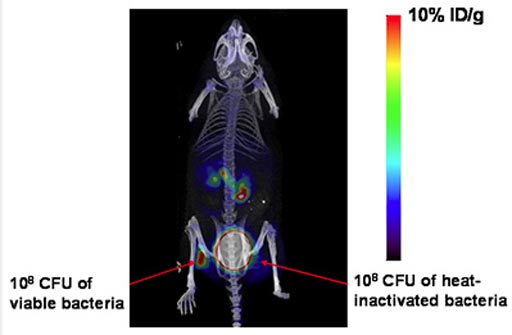Novel PET Tracer Identifies Majority of Bacterial Infections
By MedImaging International staff writers
Posted on 18 Oct 2017
A new positron emission tomography (PET) imaging agent offers a non-invasive method of detecting infection and monitoring antibiotic therapy.Posted on 18 Oct 2017
Developed by researchers at Stanford University School of Medicine (CA, USA) and Thermo Fisher Scientific (Hanover Park, IL, USA), the new PET tracer is a derivative of maltose labeled with radioactive fluorine-18 (18F). The researchers conducted several studies in relevant bacterial strains in cultures and in living mice, and found that the tracer, dubbed 6"-18F-fluoromaltotriose, appears to be specific to bacterial infections, targeting a maltodextrin transporter expressed in both gram-positive and gram-negative strains of bacteria.

Image: A 6\"-18F-fluoromaltotriose can detect viable E. coli bacteria one hour of implantation (Photo courtesy of Stanford University).
The researchers found that 6″-18F-fluoromaltotriose was also able to detect Pseudomonas aeruginosa in a clinically relevant mouse model of wound infection. In a rat model, the new agent was able to identify small bacterial foci in a heart valve. When the same rats were treated with an antibiotic, the PET signal from the cardiac tissue disappeared. According to the researchers, the properties of the tracer include sensitivity, specificity, and low background signal, which will facilitate its translation into humans. The study was published in the October 2017 issue of The Journal of Nuclear Medicine.
“We really lack tools in the clinic to be able to visualize bacterial infections. What we need is something that bacteria eat that your cells, so-called mammalian cells, do not,” said senior author Sanjiv Sam Gambhir, MD, PhD, chair of the radiology department at Stanford University School of Medicine. “As it turns out, there is such an agent, and that agent is maltose, which is taken up only by bacteria because they have a transporter, called a maltodextrine transporter, on their cell wall that is able to take up maltose and small derivatives of maltose.”
“The hope is that in the future when someone has a potential infection, this approach of injecting the patient with fluoromaltotriose and imaging them in a PET scanner will allow localization of the signal and, therefore, the bacteria,” concluded Dr. Gambhir. “And then, as one treats them, one can verify that the treatment is actually working; so that if it's not working, one can quickly change to a different treatment, for example, a different antibiotic.”
18F is a fluorine radioisotope that decays by positron emission 97% of the time, and electron capture 3% of the time; both modes of decay yield stable oxygen-18 (18O). 18F is an important radioisotope as a result of both its short half-life and the emission of positrons when decaying. It is primarily synthesized into fluorodeoxyglucose (FDG) for use in PET scans for cancer detection.














